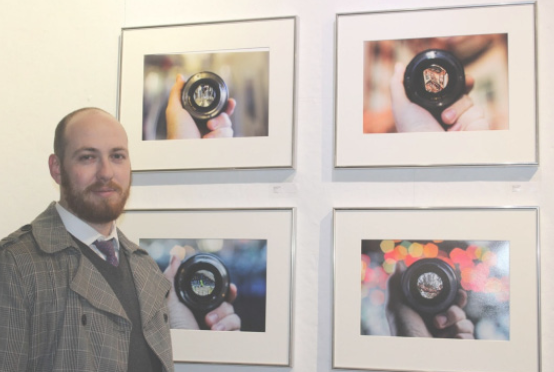By Ashley Bowden
Arts & Entertainment Editor
The photography 7 class invited students to glance into brand new perspectives of the world during their exhibition titled “Foto Hypnosis.” The show ran from Nov. 28 – Dec. 2 in the S.A.L Gallery, and a reception was held Wednesday, Nov. 29.
Each photographer captured a different aspect of life through their lens. “The images are all unique series on their own, but they come together [because] they’re all entrancing and dreamlike,” Caroline Bert, a senior photography major, said.

Caroline Bert, senior photography major.
Bert’s featured series depicted a young girl dressed in a suit blazer and tutu, commuting through life uncertain of her career path. “My series is a narrative about a little girl that’s conflicted between two big dreams,” she said. “She wants to be a ballerina, but she also wants to be a businesswoman.” The story ends with the little girl opening up a dance business. Bert incorporated physical aids with her series: worn ballet slippers, an mp3 player with headphones and a filled-out planner. She met weekly with one model to capture the story and record the young girl’s voice. This audio track, also featuring ballet music and the sounds of a big city, was playable from the mp3 player. “I did that to make the viewer feel like they’re in her world,” Bert said. “They’re hearing her voice, they’re seeing what she sees and holding her objects.”

Erin Bortel, junior photography major, displayed a series depicting “cosmic mermaids.” Using female subjects who submerged their heads in water, Bortell captured colorful abstract images from her perspective underneath a glass tank. “I used specific lighting and saturated colors to make it look like they’re in a celestial galaxy,” she said. Bortell describes the images as a cross between being underwater and in space. She has always wanted to photograph hair and explored interesting shapes within the forms it took underwater. “The colors [of hair] come out with different lighting, you can come up with different shades; it was appealing to me,” Bortell said. She hoped her photos would allow the viewers to “step out of reality and into a new one.”

David Pilcha, junior photography major.
David Pilcha, junior photography a major, used two 50-mm lenses, “using one to take an image through another,” he said. Pilcha aimed to redirect the viewer’s focus from the final result of a photograph, so he made the lens itself the subject of the photo.
Four different scenarios were depicted upside-down in the inner circle of the lens including a fire escape, a city worker maintaining public bikes, Christmas lights on a tree, and the interior of a subway car. “The whole beauty of using a 50-mm [lens] is that is has a low aperture that gives you what we call a ‘bokah’,” Pilcha said, describing the soft, blurred light in the background of his photos. “It has its own magic and its own charm that comes with the image,” he said. The eye-catching photos allowed viewers to either focus on the image through the lens or the background.
Friends and family of the artists gathered at the reception to view the final products of months of hard work. Some had personal involvement with the artist’s projects. Featured artist Wenkai Ji took portraits of various models, successfully capturing their personalities, according to his friend, Nomi Park. Park’s sister modeled for one of Ji’s photos, “She has a very shy personality and is introverted, and he captured the moment when she laughed,” Park said. Making the most of background colors, lighting and the positioning of the models themselves, Ji was able to communicate different stories through each photo.
Matt Gelfman titled his series “Skinscapes.” The black and white photos featured indistinguishable, nude body parts. His girlfriend, Kim Toledo, modeled for the series. “I wanted to focus on different abstract parts of the body more in the way you would tackle a landscape picture,” Gelfman said. He achieved this by layering her limbs in varying depths, similarly to how trees or mountains may be featured in the foreground of background of a photo. “I really wanted all the little details as you would in a landscape [photo],” Gelfman said. He wanted to tackle one of his weaknesses: landscape photography, so he combined it with his love of photographing people. As for why the images are all black and white, “There’s something more revealing when you’re forced to just look at the tones of shadows of highlights,” he said, “The separation provides a different perspective.”
The photographers worked all semester shooting thousands of new additions to their collections every week and critiquing the photos in class among their peers. After that, they narrowed their choices down to what fit best in the gallery and in their specific series.
Each series was comprised of four varying photographs that all related to one idea. “Everyone has their own perspective, and photography is all about perspective and light,” Bert said, “Each artist shows their own take on the theme in a different way.”




Be First to Comment